The caucasus is one of the most biologically rich regions in the world. The ecoregion include Armenia, Azerbaijan and Georgia, as well as small portions of Russia, Iran and Turkey. Georgia is famous for incredible hikes and landscapes, Armenia famous for its old monasteries and Baku, the capital of Azerbaijan famous for its diverse architecture and willing to become a new Dubai. All those countries used to be Soviet Union and in the capitals you can see some historical traces such as deep subways, soviet architecture and trolley buses. It is not possible to cross overland between Armenia and Azerbaijan due to historical reasons. In this case either you fly or use Georgia as a connection overland.
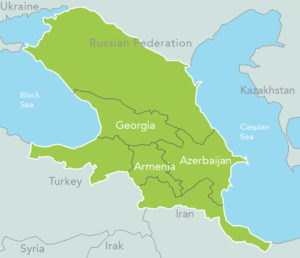
Georgia (2 weeks)
A great start for your travel in the Caucasus is Kutaisi, the legislative capital of Georgia, and its 3rd most populous city. Using Kutaisi as a basis, you can explore the surroundings such as Oktase Canyon, Kinchkha Waterfall, and hike from Shovi to Glola (camping in Udziro Lake). From there you can head to the capital Georgia.

Oktase Canyon is located in Gordi, around 50km or 1 hour from Kutaisi. The buses leave from the main bus station in Mc Donalds and you go first to Khoni (2 GEL) then to Gordi (1 GEL). The entry fee of the park is 15 GEL and you buy it in the visitor center. Keep in mind that the park is closed on mondays. You can walk from there to the Oktase Canyon between 20-30 mins or you can hire local jeeps from 40-50 GEL. Indeed the best is to book tours from Kutaisi or Tiblisi.

From Okatse Canyon it is 5km to Kinchkha Waterfall where you can walk or take a taxi for 20-30 GEL. When I went there in 2018, a visitor center was under construction and I wasn’t allowed to enter the path to the falls. I could see them from far which wasn’t impressive. On the other hand I was allowed to walk in an open path to a river surrounded by white stones. It was a nice bath!

Back to Kutaisi you can set your camping gear for a 3-4 day hike between Shovi and Glola with a night in Udziro Lake. We drove to Shovi in the first day and ended up arriving late because of preparation and food shopping. We decided to visit a famous attraction, an abandoned holiday resort once used by the Kremlin’s elite.

The resort have been left neglected for years and in the past was described as the Georgian Switzerland.

We were looking for a place to camp and were lucky enough to be allowed to stay for one night behind this historical building. We asked the person responsible for the hotel in front of the abandoned resort.
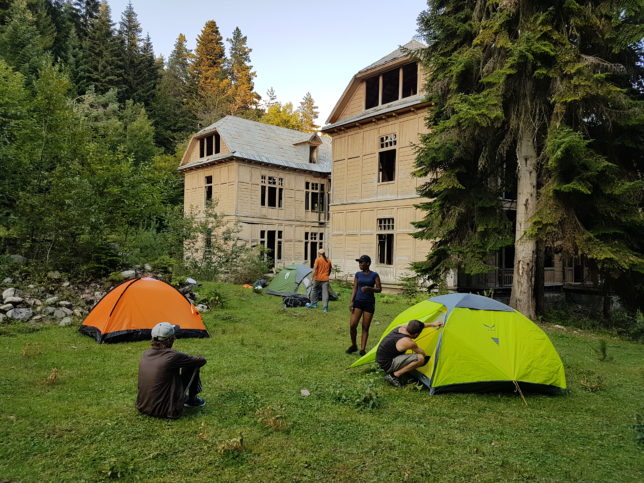
In the next morning we packet our stuff and headed for adventure, starting with a beautiful tundra landscape filled with pine trees. A detailed itinerary about the hike with distances and step-by-step is explained here.

We did the hike from Shovi to Glola, but most of the people do it the other way around. The reason is because the hard and steep part of the hike is between Shovi and Udziro Lake. Some amazing views could be seen from the top.

Took us pretty much the entire day to hike 11km and reach the lake. The hike starts in the road and the marker is 500m before the entrance to the Shovi resort (elevation 1470m). Even tough it says in the sign that it takes only 6 hours to reach the Lake, we definitely took more than that. From the Geske pass (3074m), the highest altitude from the hike you can see the Udziro Lake.

We arrived in the sunset, built our tents and cooked some pasta for dinner. A few locals and hikers were already there. The lake in the morning is gorgeous and I definitely recommend to swim on it. When I did it felt like between 8 to 12 degrees Celsius.

The next day it took us about 6 hours to reach Glola, going down was way easier. You can get to Kutaisi in the next day then head to Tbilisi, Georgia capital. This city is quite unique, is a mix of historical buildings and modern architecture. The city has many viewpoints but the most famous is the one with Kartlis Deda Monument, the mother of Georgia.

The old town has beautiful houses and some of them has a set of grapes. Home made wine is very traditional in the Caucasus region, and trying them is a must. The leaning tower of Tbilisi, attached to the theatre of renowned puppeteer Rezo Gabriadze, is a modern clock tower inaugurated in 2011.

Some modern structures can also seems around the city such as the Bridge of Peace, a pedestrian glass and steel path over the Kura River. At night is is illuminated with numerous LEDs.

You can’t leave Georgia’s capital without trying one of the sulphur baths in the Abanotubani district. The most famous one is Orbeliani Bathhouse. The mosque-style architecture is also very attractive for pictures outside.
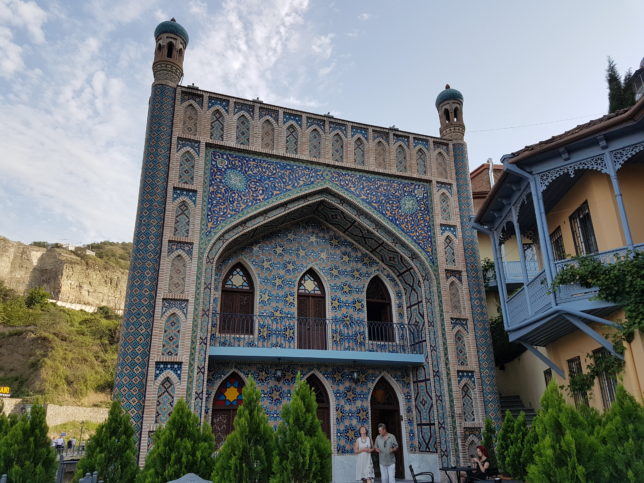
You can spend from 10 to 15 days to do all those activities in Georgia, it will depend mostly on your logistics and If you book tours or not.
Armenia (3 days)
There is a daily sleeper train from Tbilisi train station to Yerevan, capital of Armenia. You can get information about directions and prices in the information center. Buses, mini vans and shared cars are also available all day long from the Armenian District in Tbilisi.

I took the train on my way to Armenia and headed back with a mini-van. The train to go back to Georgia leaves in the afternoon and arrive in Tbilisi before sunrise. The station in Yerevan is Soviet style and there was an amazing local market happening on my arrival in the morning.
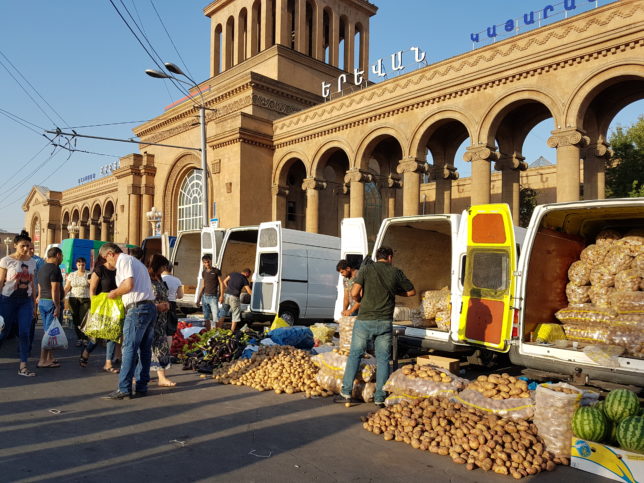
From the 3 capitals of the Caucasus countries, Yerevan is the less developed and has more Soviet remain buildings. You can get SIM cards right nearby the station and is very cheap. The first thing you notice are the deep subway stations with traditional architecture.

The main attraction of Yerevan is the Cascade, a giant stairway made of limestone that has its construction started in 1971 and was partially completed in 1980. Inside the Cascade, underneath the steps, there are multiple exhibit halls which compose the Cafesjian Center for the Arts.

The second most popular sightseeing is Victory Park and the Mother Armenia. In spring 1962, the statue of Stalin was removed, and replaced by the Mother Armenia statue, that has a height of 22 meters or 51, including the pedestal. The statue is built of hammered copper while the pedestal-museum is of basalt. The museum inside is free of charge but employees will ask for donations.

If you enjoy old monasteries, is worth taking a day or two to visit the countryside. Few monasteries similar to this one can be seen in the middle of the jungle and on top of mountains.

Baku (4 days)
The capital of Azerbaijan was quite a surprise for me. Many people told me 3 days would be plenty but I quite enjoyed it and could stay a couple of days more. The city has a mixture of architecture from medieval to soviet to ultra-modern. Start your tour from the alleys of old town.

After enjoying the fortified stone architecture you can head to the Heydar Aliyev Center, a modern museum complex noted for its unique carved style and sharp angles. You might be lucky and find a girl with a teddy bear.

One of my favorite buildings was the government house of Baku that host various state ministries of Azerbaijan. Designed for 5500 people and constructed between 1936 — 1952, the building is located in Neftchiler Avenue in front of the Boulevard.
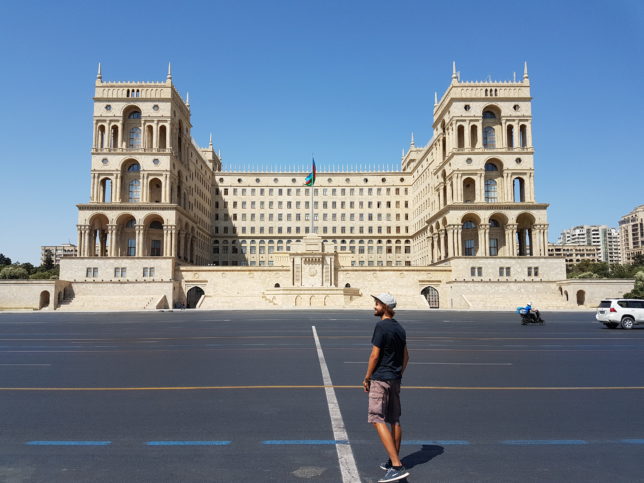
Built between 2007 and 2012 the Flame Towers is a trio of skyscrapers representing the modernization of the city. The towers symbolize the long history of fire worshippers and one of them is the tallest building in the country, with a height of 182 m.

The Caucasus is a region full of surprises, from gorgeous landscapes, to old monasteries and diversified architecture due to the soviet period and the modernization. Have you even been there?

